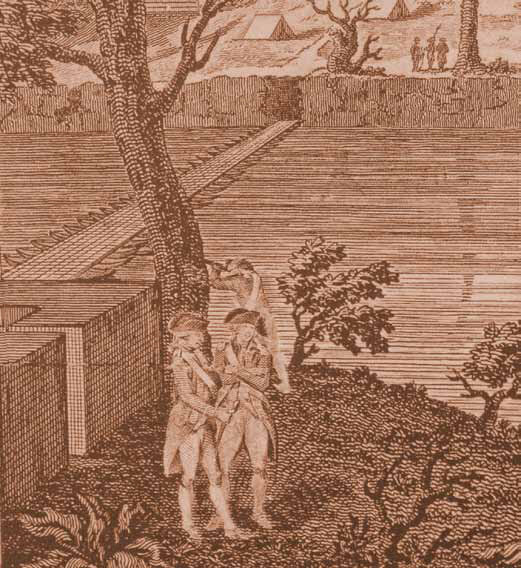Bridge of Boats
Bridge of Boats
In 1777, British General John Burgoyne led an invasion from Canada, hoping to take control of the Hudson River and Lake Champlain corridor. By August, Burgoyne had advanced to the Hudson River. He decided to continue south by crossing from the east to the west bank of the Hudson. His plan was to march on to Albany. On the west side, Burgoyne’s army would have access to a better road. This path would also lead to decisive battles with the Rebel army.
The British had an enormous amount of equipment to carry, so Burgoyne resolved to build a bridge of boats across the Hudson. Burgoyne’s troops lashed bateaux — (oversized rowboats) side-by-side across the river and covered them with planks. They were anchored to both shores and provided a quick — if somewhat unsteady — bridge.
By the 1630s, the Mohicans had been driven from the Saratoga area by their long-standing enemies, the Mohawks. The Mohawks remained in their large defensive villages in the Mohawk Valley, but used the Saratoga area to hunt and fish. Tensions among tribes escalated as the Mohawks and other members of the Iroquois Confederacy sought new hunting grounds to feed the European's demand for beaver pelts.
Heavy rains caused the bridge to break apart, briefly dividing Burgoyne’s army on both sides of the river. Repairs were made and Burgoyne’s men began their advance toward destiny, abandoning headquarters at the Duer House in Fort Miller on September 10. Looking north, there are visible cuts in the riverbank that may indicate where the troops accessed the bridge of boats.
An example
of the type of bateau used to create the bridge of boats
Bridge of Boats.
Artist rendering by Tim Forbes
Diagram of Bridge of Boats Construction.
Illustration by J. B. Lossing
Detail of View
of the West Bank of the Hudson’s River 3 Miles above Still Water (London, 1789) showing use of bridge of boats. Photo courtesy of Saratoga National Historical Park. Lossing






